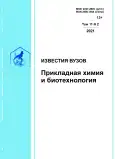The role of Arabidopsis thaliana photoreceptors in regulating the process of state transitions
- Авторлар: Belkov V.I.1, Belogub K.E.2, Garnik E.Y.1, Tarasenko V.I.1, Konstantinov Y.M.1,2
-
Мекемелер:
- Siberian Institute of Plant Physiology and Biochemistry SB RAS
- Irkutsk State University
- Шығарылым: Том 11, № 2 (2021)
- Беттер: 251-259
- Бөлім: Physico-chemical biology
- URL: https://journals.rcsi.science/2227-2925/article/view/300920
- DOI: https://doi.org/10.21285/2227-2925-2021-11-2-251-259
- ID: 300920
Дәйексөз келтіру
Толық мәтін
Аннотация
Авторлар туралы
V. Belkov
Siberian Institute of Plant Physiology and Biochemistry SB RAS
Email: anvad.irk@rambler.ru
K. Belogub
Irkutsk State University
Email: kristina200298@yandex.ru
E. Garnik
Siberian Institute of Plant Physiology and Biochemistry SB RAS
Email: elga74@yandex.ru
V. Tarasenko
Siberian Institute of Plant Physiology and Biochemistry SB RAS
Email: vslav@inbox.ru
Yu. Konstantinov
Siberian Institute of Plant Physiology and Biochemistry SB RAS; Irkutsk State University
Email: yukon@sifibr.irk.ru
Әдебиет тізімі
- Han X., Tohge T., Lalor P., Dockery P., Devaney N., Esteves-Ferreira A.A., et al. Phytochrome A and B regulate primary metabolism in Arabidopsis leaves in response to light // Frontiers in Plant Science. 2017. Vol. 8. P. 1394. https://doi.org/10.3389/fpls.2017.01394
- Paik I., Huq E. Plant photoreceptors: Multifunctional sensory proteins and their signaling networks // Seminars in Cell and Developmental Biology. 2019. Vol. 92. P. 114-121. https://doi.org/10.1016/j.semcdb.2019.03.007
- Ma D., Li X., Guo Y., Chu J., Fang S., Yan C., et al. Cryptochrome 1 interacts with PIF4 to regulate high temperature-mediated hypocotyl elongation in response to blue light // PNAS. 2016. Vol. 113. Issue 1. P. 224-229. https://doi.org/10.1073/pnas.1511437113
- Kreslavski V.D., Los D.A., Schmitt F.-J., Zharmukhamedov S.K., Kuznetsov V.V., Allakhverdiev S.I. The impact of the phytochromes on photosynthetic processes // Biochimica et Biophysica Acta (BBA) - Bioenergetics. 2018. Vol. 1859. Issue 5. P. 400-408. https://doi.org/10.1016/j.bbabio.2018.03.003
- Colombo M., Suorsa M., Rossi F., Ferreri R., Tadini L., Barbato R., et al. Photosynthesis control: an underrated short-term regulatory mechanism essential for plant viability // Plant Signaling & Behavior. 2016. Vol. 11. Issue 4. e1165382 (6 p.). https://doi.org/10.1080/15592324.2016.1165382
- Dietzel L., Brautigam K., Pfannschmidt T. Photosynthetic acclimation: state transitions and adjustment of photosystem stoichiometry-functional relationships between short-term and long-term light quality acclimation in plants // FEBS Journal. 2008. Vol. 275. Issue 6. P. 1080-1088. https://doi.org/10.1111/j.1742-4658.2008.06264.x
- Caffarii S.A., Tibiletti T., Jennings R., Santabarbara S. A comparison between plant photosystem I and photosystem II architecture and functionning // Current Protein and Peptide Science. 2014. Vol. 15. Issue 4. P. 296-331. https://doi.org/10.2174/1389203715666140327102218
- Wunder T., Liu Q., Aseeva E., Bonardi V., Leister D., Pribil M. Control of STN7 transcript abundance and transient STN7 dimerisation are involved in the regulation of STN7 activity // Planta. 2013. Vol. 237. Issue 2. P. 541-558. https://doi.org/10.1007/s00425-012-1775-y
- Rochaix J.-D., Lemeille S., Shapiguzov A., Samol I., Fucile G., Willig A., et al. Protein kinases and phosphatases involved in the acclimation of the photosynthetic apparatus to a changing light environment // Philosophical Transactions of the Royal Society B. Biological Sciences. 2012. Vol. 367. Issue 1608. P. 3466-3474. https://doi.org/10.1098/rstb.2012.0064
- Verdaguer D., Jansen M.A.K., Llorens L., Morales L.O., Neugart S. UV-A radiation effects on higher plants: exploring the known unknown // Plant Science. 2017. Vol. 255. P. 72-81. https://doi.org/10.1016/j.plantsci.2016.11.014
- Kreslavski V.D., Lyubimov V.Yu., Shirshiko-va G.N., Shmarev A.N., Kosobryukhov A.A., Schmitt F.J., et al. Preillumination of lettuce seedlings with red light enhances the resistance of photosynthetic apparatus to UV-A // Journal of Photochemistry and Photobiology B: Biology. 2013. Vol. 122. P. 1-6. https://doi.org/10.1016/j.jphotobiol.2013.02.016
- Khudyakova A.Yu., Kreslavski V.D., Shirshikova G.N., Zarmukhamedov S.K., Kosobryukhov A.A., Allakhverdiev S.I. Resistance of Arabidopsis thaliana L. photosynthetic apparatus to UV-B is reduced by deficit of phytochromes B and A // Journal of Photochemistry and Photobiology B: Biology. 2017. Vol. 169. P. 41-46. https://doi.org/10.1016/j.photobiol.2017.02.024
- Aronsson H., Jarvis P. A simple method for isolating import-competent Arabidopsis chloroplasts // FEBS Letters. 2002. Vol. 529. Issue 2-3. P. 215220. https://doi.org/10.1016/s0014-5793(02)03342-2
- Pribil M., Pesaresi P., Hertle A., Barbato R., Leister D. Role of plastid protein phosphatase TAP38 in LHCII dephosphorylation and thylakoid electron flow // PLoS Biology. 2010. Vol. 8. Issue 1. e1000288 (12 p.). https://doi.org/10.1371/journal.pbio.1000288
- Nijtmans G.J., Henderson N.S., Holt I.J. Blue native electrophoresis to study mitochondrial and other protein complexes // Methods. 2002. Vol. 26. Issue 4. P. 327-334. https://doi.org/10.1016/S1046-2023(02)00038-5
- Ni Z., Kim E.-D., Ha M., Lackey E., Liu J., Zhang Y., et al. Altered circadian Rhythms regulate growth vigour in hybrids and allopolyploids // Nature. 2009. Vol. 457. Issue 7227. P. 327-331. https://doi.org/10.1038/nature07523
- Wunder T., Liu Q., Aseeva E., Bonardi V., Leister D., Pribil M. Control of STN7 transcript abundance and transient STN7 dimerisation are involved in the regulation of STN7 activity // Planta. 2013. Vol. 237. P. 541-558. https://doi.org/10.1007/s00425-012-1775-y
- Fey V., Wagner R., Brautigam K., Wirtz M., Hell R., Dietzmann A., et al. Retrograde plastid redox signals in the expression of nuclear genes for chloroplast proteins of Arabidopsis thaliana // The Journal of Biological Chemistry. 2005. Vol. 280. Issue 7. P. 5318-5328. https://doi.org/10.1074/jbc.M406358200
- Carvalho R.F., Campos M.L., Azevedo R.A. The role of phytochrome in stress tolerance // Journal of Integrative Plant Biology. 2011. Vol. 53. Issue 12. P. 920-929. https://doi.org/10.1111/j.1744-79 09.2011.01081.x
- Kreslavski V.D., Kosobryukhov A.A., Schmitt F.-J., Semenova G.A., Shirshikova G.N., Khudyako-va A.Y., et al. Photochemical activity and the structure of chloroplasts in Arabidopsis thaliana L. mutants deficient in phytochrome A and B // Protoplasma. 2017. Vol. 254. Issue 3. P. 1283-1293. https://doi.org/10.1007/s00709-016-1020-9
- Casal J.J. Photoreceptor signaling networks in plant responses to shade // Annual Review of Plant Biology. 2013. Vol. 64. P. 403-427. https://doi.org/10.1146/annurev-arplant-050312-120221
- Rusaczonek A., Czarnocka W., Kacprzak S., Witon D., Slesak I., Szechynska-Hebda M., et al. Role of phytochromes A and B in the regulation of cell death and acclimatory responses to UV stress in Arabidopsis thaliana // Journal of Experimental Botany. 2015. Vol. 66. Issue 21. P. 6679-6695. https://doi.org/10.1093/jxb/erv375
Қосымша файлдар









